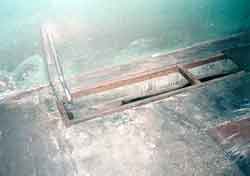





|
Slips, Trips and Falls


Slips, trips, and falls can cause back injuries, strains and sprains, contusions, and fractures.
How do slips, trips, and falls happen?
Slips, trips, and falls can cause back injuries, strains and sprains, contusions, and fractures.
How do slips, trips, and falls happen?
Falls
to same level:
- Floors,
platforms and stairways may be slippery from water, blood, or
poultry fat and grease. View
slide
- Employees
may trip over boxes, electrical cords, equipment, or other items
that are left in aisles and walkways. View
slide
- Floors
may be uneven or have depressions or shallow holes or uncovered
floor drains that cause employees to trip. View
slide
Falls
from a higher level to a lower level:
- Stairways
may have missing rails or treads, or the riser height may not
be uniform. View slide
- Elevated
work surfaces may not have guardrails or toeboards.
- The
distance between rungs on portable ladders may not be uniform,
the ladders may not be equipped with non-slip safety feet, or
employees may not be trained in the safe use of ladders. View
slide
What can employers and employees do to prevent slips, trips, and falls in the workplace?
- Clean up blood and grease as promptly and frequently as possible.
- Provide non-slip surfaces on floors that will be wet.
- Use slip-resistant footwear.
- Keep aisles and passageways clear of obstructions and tripping hazards.
- Make sure aisles are wide enough for the intended use.
- Make sure stairs have proper handrails, that treads and risers are maintained, and that treads have a slip-resistant surface.
- Make sure elevated storage and work surfaces have guardrails, toeboards,
and a permanent means of access.
- Make sure that floor drains are covered by grates.
- Maintain ladders in good condition, with uniformly-spaced rungs and non-slip safety feet.
- Train employees in the safe use of ladders.
Specific OSHA Requirements
OSHA Requirements for the prevention of slips, trips, and falls are contained in
29 CFR 1910
Subpart D, Walking-working surfaces.
The sections included in this subpart are: (Overheads)
- Definitions,
- General requirements (including requirements for housekeeping),
- Guarding floor and wall openings and holes,
- Fixed industrial stairs,
- Portable wood ladders,
- Portable metal ladders,
- Fixed ladders,
- Safety requirements for scaffolding,
- Manually propelled mobile ladder stands and scaffolds (towers), and
- Other working surfaces.
Additional explanation of the OSHA requirements for
walking-working surfaces can be found in OSHA's
Small
Business Handbook (OSHA Publication 2209-02R). Also available as
a 260 KB PDF,
56 pages.
29
CFR 1910 Subpart
I, Personal protective equipment is also applicable as it applies
to the use of non-slip safety footwear. See especially:
Another useful OSHA publication is:
NOTE:
Employers in states with state-run safety and health plans should
check with their
state
agency. Their state may enforce standards that, while "as effective
as federal standards," may not be identical to the federal requirements.
Accessibility Assistance:
Contact the OSHA Directorate of Science, Technology and Medicine at 202-693-2300
for assistance accessing OSHA PDF materials.
|

